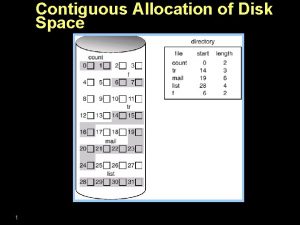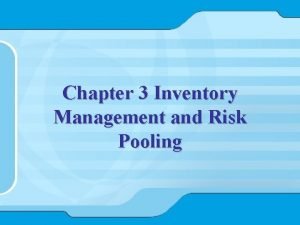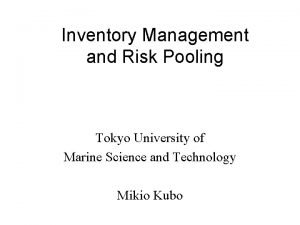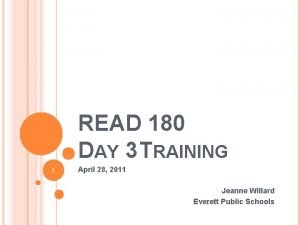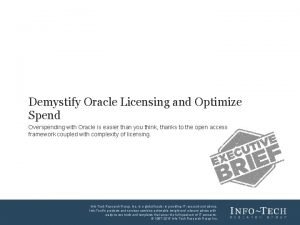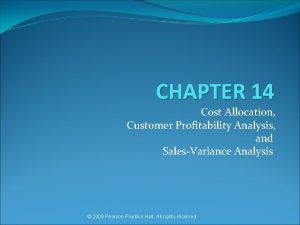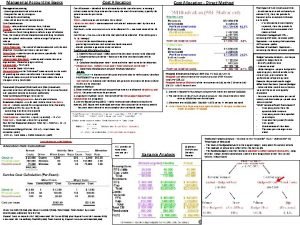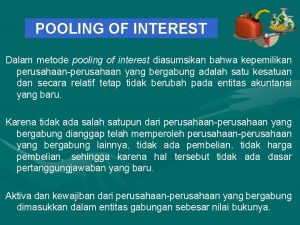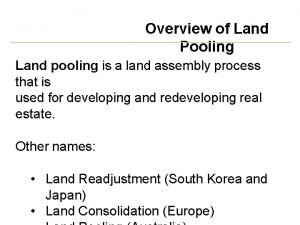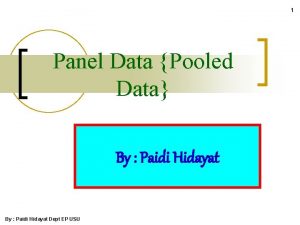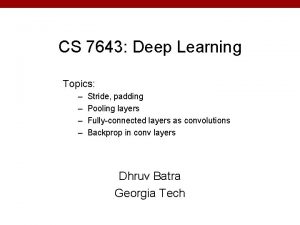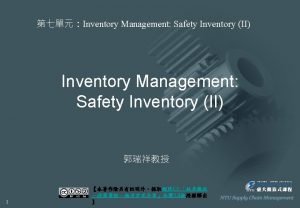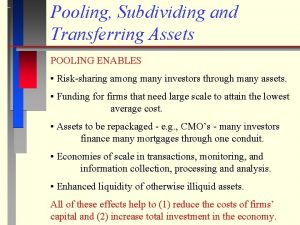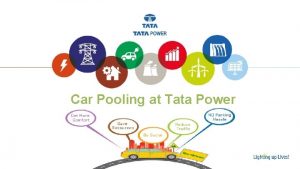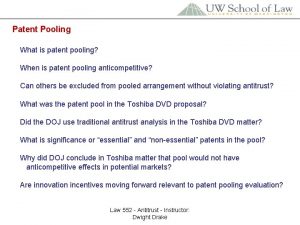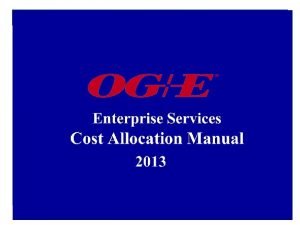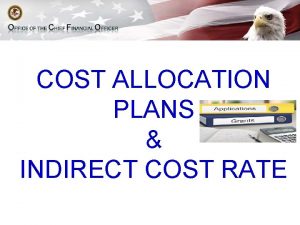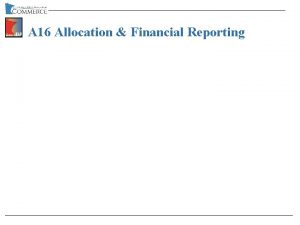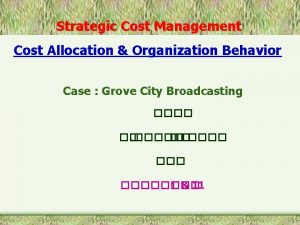OnLine Financial Management Workshops Cost Allocation Cost Pooling







































- Slides: 39

On-Line Financial Management Workshops Cost Allocation, Cost Pooling & Time Distribution June 2009 1

Financial Management Workshop Cost Allocation, Cost Pooling & Time Distribution 2

Topics We Will Cover § Cost Allocation § Cost Pooling § Cost Allocation Plans § Time Distribution 3

Federal Requirements & Guidance § § § OMB Circular A-87 OMB Circular A-122 OMB Circular A-21 48 CFR Part 31 45 CFR Part 74, Appendix E Guidance on direct and indirect costs 4

What Is Cost Allocation? ? Distribution of Allowable Costs That Benefit Your Grant Costs Direct Shared Indirect 5

Types of Costs § Direct – Single Cost Objective § Shared – Multiple Cost Objectives, or – Multiple Fund Sources § Indirect – Generally Overhead 6

Treatment of Costs § Direct Charge Whenever Possible § Consistent Treatment – In Accounting System – Over Time § Measuring Benefit – Benefit Determines Allocation 7

What Are Direct Costs? § Those costs that can be readily identified with a particular cost objective. § Examples (program specific): – Salaries – Space – Supplies – Telecommunications 8

What Are Indirect Costs? § Those costs that are not readily identifiable with a particular cost objective § Examples: – Salaries – Space – Supplies – Telecommunications (Management and Overhead Costs Supporting Entire Organization) 9

Cost Objectives § Intermediate – Cost Pools or “Cost Staging Areas” § Final – Funding Source – Cost Category 10

Cost Pool Considerations Limited to Shared & Indirect Costs Limited to Actual Costs Described in CAP Combined Administrative Costs Prorated Personnel Services Costs Prorated Nonpersonnel Services Costs § Allocation of Pools Should Not Be Burdensome § § § 11

Types of Cost Pools § Administrative § Operating § Facilities or maintenance § Specific Function or Activity § Organizational § System-wide 12

Allocation Methodologies § In Aggregate – All Shared Costs are Totaled § Activity based – Costs of One Particular Activity are Pooled § Item of cost based – Each Shared Item of Cost Allocated Using Separate Methodology § Any Combination of Above 13

Cost Allocation Requirements & Standards § Requirements – Result in Equitable Distribution of Costs – Base Corresponds to Allocated Costs – Efficient to Use and Consistently Applied § Standards – Consistent with GAAP – Consistent with OMB Circulars – Accepted by Independent Auditors – Supported by Actual Cost Data 14

Acceptable Allocation Bases § Fair & Equitable § Minimal distortion § Actual costs only § General acceptability § Timely management control § Materiality, cost, and practicality of use § Controllable § Direct relationship to costs 15

What Is the Best Allocation Base? § No Single Answer § Varies Based on Type of Organization and Types of Costs § Should Relate to Costs Being Allocated § Let’s Look at Some Possible Bases 16

Unacceptable Allocation Bases § Funds Availability or Budgets § Job Descriptions § Pre-determined Staff Hours § Planned Participant Levels § Prior Period Results 17

Input-Based Allocation § Resources Used § Traditional Method § Allocated at Time Cost Is Incurred § Documentation of Use and Variances – How Input is Used – How Usage Varies 18

Commonly Used Input Bases § Staff Time – Time Sheets § Facilities – Space Usage § Accounting Services – # of Transactions § Equipment – Usage or Machine Hours § Copy Machine - # of Copies 19

Output-Based Allocation § Centralized Intake – Number of Participants § Job Placement – Number of Placements § Case Management – Number of Current Participants 20

Allocating Program-Related Administrative Costs § Do Not Relate to G&A or Overhead § Pursuant to WIA 20 CFR 667. 220 § Examples – Staff Time Prorated Between Administration and Program – Space Usage 21

What is a Cost Allocation Plan? (CAP) § A document that identifies, accumulates, and distributes allowable direct and indirect costs and declares the allocation methods used for distribution. Federally approved Cost Allocation Plan 22

Types of CAPs § Indirect Cost Plan – Addressed in OMB Cost Circulars – Federal Agency Approval – Includes an Indirect Cost Rate § CAP of the Organization – Shared Indirect Costs – Awarding Agency Approval 23

Cost Allocation Plan Considerations § Must Include a Process for Reconciliation and Adjustment § Should Be Periodically Validated and Updated § Must Be a Written Document § Requires Official Signature 24

Elements of a CAP § Background and Mission Statement § Organizational Chart § Financial Statements and Budgets § Description of Pooled or Joint Costs § Methods Used to Allocate Costs § Certification 25

Benefits of a CAP § Management Tool § Equitable Sharing of Costs § Establishes Financial Management Standards § Meets Cost Principles and Standards § Eliminates Arbitrary Methods of Charging Costs § Standardizes Financial Practices 26

What Is Time Distribution? § System That Distributes Staff Salaries & Benefits • Based on Staff Time • Multiple Fund Sources Paying Staff • Must Be Documented • Source of Requirements – OMB Circulars A-122 and A-87 27

Time Distribution Documentation § Recording Actual Time Spent on Each Cost Objective § Proof That Individual Works on Only One Cost Objective § Varies Based on Circumstances 28

Time Distribution Methods § Time & Attendance Records – Personnel Activity Reports (PARs) – Various Methods § Time Sampling Methods – Cognizant Agency Approval § Measurable Work Outputs § Allocating Nonpersonnel Costs 29

Common Compliance Findings Associated with … § § Cost Allocation Indirect Costs Charging Staff Time Administrative Cost Limits 30

Possible Solutions § Awareness of Unacceptable Allocation Bases § Familiarity With Grant Agreement Requirements § Familiarity With Cost Principles § Remembering You Can Only Use ETA Grant Funds to Pay for Costs Which Benefit Your ETA Grant!! 31

Test Your Knowledge! § Question 1. What are the 3 types of costs that can be charged to your grant? 32

Answer Key § Answer 1. Direct, Shared, Indirect 33

Test Your Knowledge! § Question 2. What is an acceptable cost allocation basis? Choose one: a. Prior period performance data b. Actual costs c. Funds Availability 34

Answer Key § Answer 2. (b. ) Actual Costs 35

Test Your Knowledge! § Question 3. When a staff person works on multiple Programs what is a sound acceptable method for allocating his or her costs? 36

Answer Key § Answer 3. Time Sheets – Time Distribution Records 37

Resources Guides to Developing Cost Allocation Plans and Indirect Cost Rate Agreements § Indirect Cost Rate Determination Guide – Issued by DOL–OASAM – For Non-Profits – www. dol. gov/oasam/programs/boc/ocd-guidemain. htm § ASMB C-10 Guide – Issued by HHS – For State and local governments – Includes a Q&A section – www. hhs. gov/grantsnet/state/asmbc 10. pdf § OMB Circulars – www. whitehouse/gov/omb/circulars/index. html 38

Questions? If you have questions, please contact your Federal Project Officer 39
 Linked allocation
Linked allocation Inventory pooling examples
Inventory pooling examples Inventory management and risk pooling
Inventory management and risk pooling Risk pooling example
Risk pooling example System 44 scope and sequence
System 44 scope and sequence Psea retirement calculator
Psea retirement calculator Mbti activities for small groups
Mbti activities for small groups Cramped workshops set up in shabby tenement buildings
Cramped workshops set up in shabby tenement buildings Glutenstapeling
Glutenstapeling Workshops for rectors
Workshops for rectors Oracle licensing workshops
Oracle licensing workshops Social thinking tree
Social thinking tree Sayville academic center
Sayville academic center Google anay
Google anay Canadian bioinformatics workshops
Canadian bioinformatics workshops Bioinformatics.ca
Bioinformatics.ca Canadian bioinformatics workshops
Canadian bioinformatics workshops Canadian bioinformatics workshops
Canadian bioinformatics workshops Financial markets and the allocation of capital
Financial markets and the allocation of capital Cloud cost allocation
Cloud cost allocation Support department adalah
Support department adalah Cost allocation and profitability analysis
Cost allocation and profitability analysis Cost allocation direct method
Cost allocation direct method Cost of capital in financial management
Cost of capital in financial management Ttx railcar pooling experts
Ttx railcar pooling experts Pooling of interest adalah
Pooling of interest adalah Pooling vs unitization
Pooling vs unitization What is land pooling
What is land pooling Pooling layer backpropagation
Pooling layer backpropagation Contoh pooled data
Contoh pooled data Alireza akhavan github
Alireza akhavan github Swipe vs wipe pattern
Swipe vs wipe pattern Pooling layer
Pooling layer Product pooling example
Product pooling example Max pooling layer
Max pooling layer Cs 7643 deep learning github
Cs 7643 deep learning github Densenet number of parameters
Densenet number of parameters Pooling stride
Pooling stride Also known as electron pooling
Also known as electron pooling The required safety inventory
The required safety inventory
